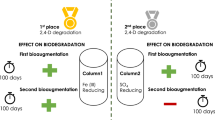Abstract
Microbial biobarriers are an established technique for cleansing contaminants from aquifers. This study evaluated their use under well-drained conditions within the vadose or unsaturated zone. Three sets of sand filled columns, the positive control, field-capacity, and sub-field-capacity groups, contained biobarriers formed by mixing sand with sawdust and soybean oil. The biobarriers were positioned 1 m from the top of the 145 cm columns. A fourth set of column, the negative control, contained no biobarrier. The positive control group’s biobarriers were saturated while biobarriers in the other groups were allowed to drain. At intervals water containing 20 mg l−1 NO −3 –N was applied to the columns, the water was allowed to percolate through the columns, and the effluents were collected and analyzed. The biobarriers were highly effective at removing NO −3 . NO −3 –N in the effluents from the field-capacity, sub-field-capacity, and positive control groups averaged 0.4 ± 0.1, 0.6 ± 0.1, and 0.8 ± 0.1 mg l−1, respectively, during the final weeks of the study while effluents from the negative control group averaged 17.9 ± 0.4 mg l−1. The barriers removed NO −3 even when the water content was in the 20–40% pore filled space range. During the 12-week study the field-capacity barriers lost 5.6% of their organic content while those in the sub-field-capacity group lost no detectable organic matter indicating that the barriers contained sufficient substrate to last for several years. Vadose zone biobarriers could provide a useful means of protecting surface waters and aquifers from NO −3 .



Similar content being viewed by others
References
Blowes DW, Robertson WD, Ptacek CL, Merkley C (1994) Removal of agricultural nitrate from tile-drainage effluent water using in-line bioreactors. J Contam Hydrol 15:207–221
Blowes DW, Ptacek CJ, Benner SG, McRae CWT, Bennett TA, Puls RW (2000) Treatment of inorganic contaminants using permeable reactive barriers. J Contam Hydrol 45:123–137
Bouyoucos GJ (1962) Hydrometer method improved for making particle size analysis of soils. Agron J 54:464–465
Flere JM, Zhang TC (1999) Nitrate removal with sulfur-limestone autotrophic denitrification processes. J Environ Eng 125:721–729
Gilbert O, Pomierny S, Rowe I, Kalin RM (2008) Selection of organic substrates as potential reactive materials for use in a denitrification permeable reactive barrier (PRB). Bioresource Technol 99:7587–7596
Greenburg AE, Clesceri LS, Eaton AD (eds) (1992) Standard methods for the examination of water and wastewater, 18th edn. Sect. 8010 C. Basic requirements for toxicity tests. American Public Health Association, American Water Works Association and Water Environmental Federation, Washington, DC
Hunter WJ (2001) Use of vegetable oil in a pilot-scale denitrifying wall. J Contam Hydrol 53:119–131
Hunter WJ (2002) Bioremediation of chlorate or perchlorate contaminated water using permeable barriers containing vegetable oil. Curr Microbiol 45:287–292
Hunter WJ (2003) Accumulation of nitrite in denitrifying barriers when phosphate is limiting. J Contam Hydrol 66:79–919
Hunter WJ (2007) An Azospira oryzae (syn Dechlorosoma suillum) strain that reduces selenate and selenite to elemental red selenium. Curr Microbiol 54:376–381
Hunter WJ (2008) Remediation of drinking water for rural populations. In: Follett RF, Hatfield JL (eds) Nitrogen in the environment: sources, problems and management. Elsevier Science BV, Holland, pp 597–621
Hunter WJ, Follett RF, Cary JW (1997) Use of vegetable oil to stimulate denitrification and remove nitrate from flowing water. Trans ASAE (Am Soc Agric Eng) 40:345–353
Hunter WJ, Kuykendall LD (2005) Removing selenite from groundwater with an in situ biobarrier: laboratory studies. Curr Microbiol 50:145–150
Khan AR, Chandra D, Quraishi S, Sinha RK (2000) Soil aeration under different soil surface conditions. J Agric Crop Sci 185(74):105–112
Lee MD, Buchanan RJ Jr, Ellis DE (2000) Laboratory studies using edible oils to support reductive dechlorination. In: Wickranayake GB, Gavaskar AR, Alleman BC, Magar VS (eds) Bioremediation and phytoremediation of chlorinated and recalcitrant compounds. Battelle Press, Columbus, OH, pp 47–53
Merrill AG, Benning TL (2006) Ecosystem type differences in nitrogen process rates and controls in the riparian zone of a montane landscape. For Ecol Manage 222:145–161
Myrold DD, Tiedje JM (1985) Establishment of denitrification capacity in soil: effects of carbon, nitrate and moisture. Soil Biol Biochem 17:819–822
Penman HL (1940) Gas and vapor movements in the soil. J Agric Sci 30:570–581
Robertson WD, Cherry JA (1995) In situ denitrification of septic-system nitrate using reactive porous media barriers: field trials. Ground Water 33:99–111
Robertson WD, Anderson MR (1999) Nitrogen removal from landfill leachate using an infiltration bed coupled with a denitrification barrier. Ground Water Monit R 19:73–80
Robertson WD, Ptacek CJ, Brown SJ (2007) Aquifer nitrate and perchlorate remediation using a wood particle layer. Ground Water Monit R 27:85–95
Robertson WD, Vogan JL, Lombardo PS (2008) Nitrate removal rates in a 15-year-old permeable reactive barrier treating septic system nitrate. Ground Water Monit R 28:65–72
Schipper LA, Vojvodic-Vukovic M (2001) Five years of nitrate removal, denitrification and carbon dynamics in a denitrification wall. Water Res 35:3473–3477
Schipper LA, McGill A (2008) Nitrogen transformation in a denitrification layer irrigated with dairy factory effluent. Water Res 42:2457–2464
Seo Y, Jang A, Bishop P (2007) Organic mulch biowall for PAH contaminated groundwater remediation. Eur J Soil Biol 43:304–309
Stolzey LH, Letey J (1964) Characterizing soil oxygen conditions with platinum electrode. Adv Agron 16:249–279
Su C, Puls RW (2006) Removal of added nitrate in cotton burr compost, mulch compost, and peat: mechanisms and potential use for groundwater nitrate remediation. Chemosphere 66:91–98
Acknowledgments
The author thanks Robin Montenieri and Kimberly LaCroix for their expert technical assistance. Manufacturer and product brand names are given for the reader’s convenience and do not reflect endorsement by the US government. This article was the work of US government employees engaged in official duties and is exempt from copyright.
Author information
Authors and Affiliations
Corresponding author
Rights and permissions
About this article
Cite this article
Hunter, W.J. Vadose Zone Microbial Biobarriers Remove Nitrate from Percolating Groundwater. Curr Microbiol 58, 622–627 (2009). https://doi.org/10.1007/s00284-009-9380-4
Received:
Revised:
Accepted:
Published:
Issue Date:
DOI: https://doi.org/10.1007/s00284-009-9380-4




